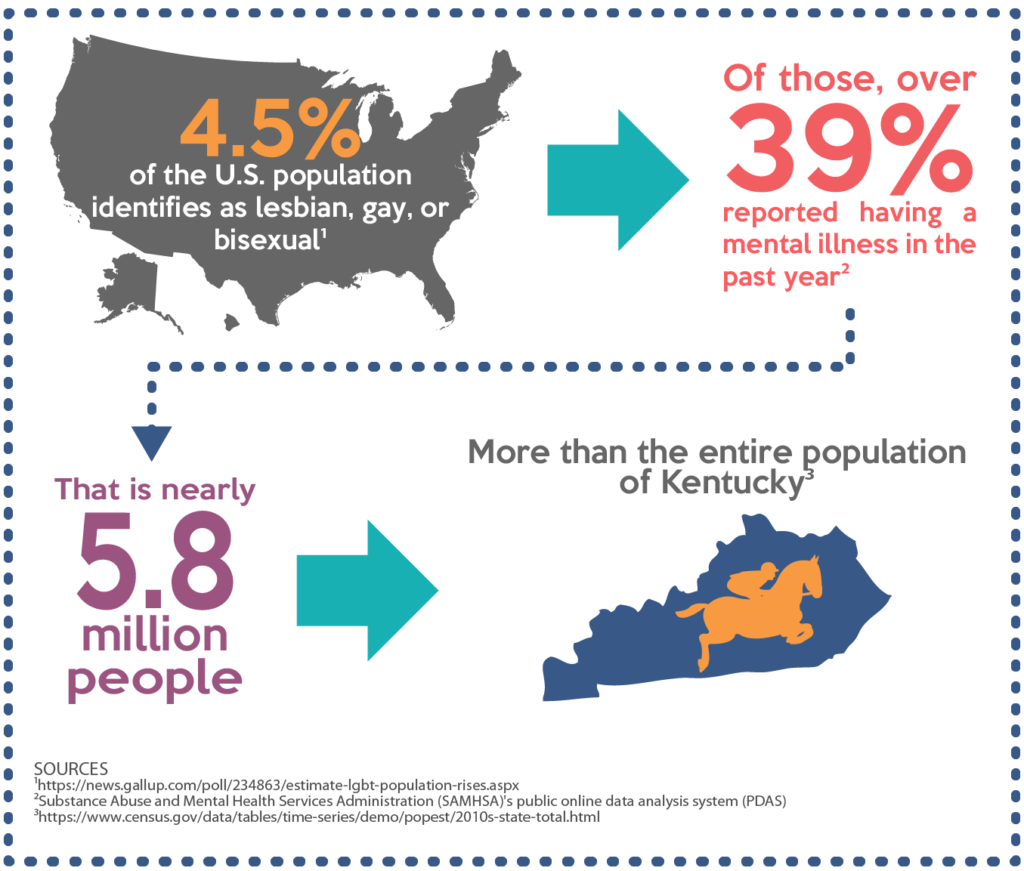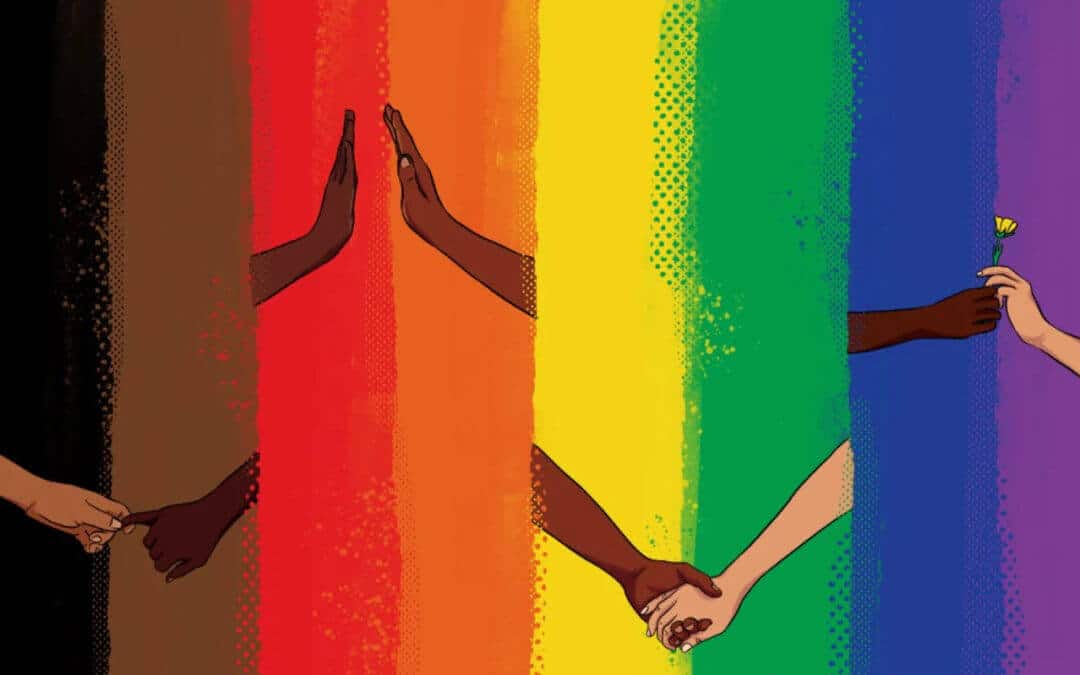The Lesbian, Gay, Bisexual, Transgender, Queer, Questioning, Intersex, Asexual (LGBTQIA+) community represents a diverse range of identities and expressions of gender and sexual orientation. In addition to these identities, members of the community are diverse in terms of race, religion, ethnicity, nationality and socioeconomic class. This intersectionality — the combined and overlapping aspects of a person’s identity — brings diversity of thought, perspective, understanding and experience. This complexity is important to understand as a unique and valuable aspect of the LGBTQIA community that can result in a strong sense of pride and resiliency.
Everyone has a sexual orientation and gender identity. Sexual orientation is who you are romantically or physically attracted to. Gender identity is the internal sense of being male, female, both or neither, which is separate from your biological sex. People who have a different sexual orientation or gender identity from most people fall under the umbrella term LGBTQIA+. It is really important to know that identifying as LGBTQIA+ is NOT a mental illness or disorder.
Although being LGBTQ+ is absolutely not a mental illness, many LGBTQ+ people experience mental health struggles. The bisexual and transgender communities have the highest rates of mental health concerns within the LGBTQ+ population. Younger members of the LGBTQ+ community struggle the most with mental health concerns of all the age groups.
Most LGBTQ+ individuals are incredibly resilient and will thrive in the face of adversity, with the help of supportive families, communities, and peers. One study even found that LGBTQ+ people used mental health services at 2.5 times higher rates than their heterosexual counterparts. However, they are also at particular risk for experiencing shame, fear, discrimination, and adverse and traumatic events.
Also, many people who identify as LGBTQ+ are part of second (and sometimes third or more) community that is marginalized. Examples of these groups are BIPOC (Black, Indigenous, or People of Color), people with a physical disability, people practicing a religion different than their neighbors, and people with low socioeconomic status. These people have complex experiences that cannot be easily addressed in one area of their life.
There are many negative stereotypes about being LGBTQ+ which makes many uncomfortable letting people know this important part of their identity. When people do openly express this part of themselves, they face the potential of rejection from peers, colleagues, and friends can exacerbate feelings of loneliness.

While belonging to the LGBTQIA community can be a source of strength, it also brings unique challenges. For those who identify as LGBTQIA, it’s important to recognize how your experience of sexual orientation and gender identity relates to your mental health.
Although the full range of LGBTQIA identities are not commonly included in large-scale studies of mental health, there is strong evidence from recent research that members of this community are at a higher risk for experiencing mental health conditions — especially depression and anxiety disorders. LGB adults are more than twice as likely as heterosexual adults to experience a mental health condition. Transgender individuals are nearly four times as likely as cisgender individuals (people whose gender identity corresponds with their birth sex) individuals to experience a mental health condition.
LGB youth also experience greater risk for mental health conditions and suicidality. LGB youth are more than twice as likely to report experiencing persistent feelings of sadness or hopelessness than their heterosexual peers. Transgender youth face further disparities as they are twice as likely to experience depressive symptoms, seriously consider suicide, and attempt suicide compared to cisgender lesbian, gay, bisexual, queer and questioning youth.
For many LGBTQIA people, socioeconomic and cultural conditions negatively impact mental health conditions. Many in the LGBTQIA community face discrimination, prejudice, denial of civil and human rights, harassment and family rejection, which can lead to new or worsened symptoms, particularly for those with intersecting racial or socioeconomic identities.
Important Risk Factors Of LGBTQIA Mental Health
Coming Out
Positive changes in societal acceptance of LGBTQIA people act as a protective factor for mental health. However, this shift in acceptance has meant that many LGBTQIA youth “come out” or share their sexual orientation or gender identity at younger developmental ages, which can impact their social experiences and relationships. This can have negative mental health impacts, particularly for youth who are not in supportive environments.
Rejection
For many in the LGBTQIA community, coming out can be a difficult or even traumatic experience. It can be difficult to cope with rejection of something as personal as one’s identity from family or close friends, within the workplace, or in a faith community.
According to a 2013 survey, 40% of LGBT adults have experienced rejection from a family member or a close friend. A 2019 school climate survey showed that 86% of LGBTQ youth reported being harassed or assaulted at school, which can significantly impact their mental health. And a 2022 report from The Trevor Project found that just 37% of LGBTQ youth identified their home as an LGBTQ-affirming space.
Trauma
Homophobia, biphobia, transphobia, bullying and feeling identity-based shame is often traumatic for people.
The LGBTQIA community faces many forms of discrimination, including: labeling, stereotyping, denial of opportunities or access, and verbal, mental and physical abuse. They are one of the most targeted communities by perpetrators of hate crimes in the country.
Such discrimination can contribute to a significantly heightened risk for PTSD among individuals in the LGBTQIA community compared to those who identity as heterosexual and cisgender.
Substance Use
Substance misuse or overuse, which may be used as a coping mechanism or method of self-medication, is a significant concern for members of this community. LGB adults are nearly twice as likely as heterosexual adults to experience a substance use disorder. Transgender individuals are almost four times as likely as cisgender individuals to experience a substance use disorder. Illicit drug use is significantly higher in high school-aged youth who identify as LGB or are unsure of their identity, compared to their heterosexual peers.
Homelessness
It is estimated that LGBTQIA youth and young adults have a 120% higher risk of experiencing homelessness — often the result of family rejection or discrimination based on gender identity or sexual orientation. This risk is especially high among Black and Native American/Alaska Native LGBTQIA youth. Many members of the LGBTQI community face the added challenge of finding homeless shelters that will accept them, and experience elevated rates of harassment and abuse in these spaces.
Suicide
Many people in this community struggle in silence — and face worse health outcomes as a result.
- The LGBTQIA population is at a higher risk than the heterosexual, cisgender population for suicidal thoughts and suicide attempts.
- High school students who identify as lesbian, gay or bisexual are more than four times as likely to have attempted suicide compared to their heterosexual peers.
- 40% of transgender adults have attempted suicide in their lifetime, compared to less than 5% of the general U.S. population.
Inadequate Mental Health Care
The approach to sexual orientation and gender identity in mental health care often groups together anyone in the LGBTQIA community, when these communities are considered at all. This method can be problematic as each sub-community faces unique challenges, rates of mental illness and experiences.
The LGBTQIA community encompasses a wide range of individuals with separate and overlapping challenges regarding their mental health. Other identity factors including race and economic status can affect the quality of care they receive or their ability to access care.
Additionally, members of this community may face harassment or a lack of cultural competency from potential providers. These experiences can lead to a fear of disclosing sexual orientation and/or gender identity due to potential discrimination or provider bias.
Confronting these barriers and mental health symptoms with an LGBTQIA-inclusive mental health provider can lead to better outcomes, and ultimately recovery.

Demographics/Societal Issues
- Among U.S. adults, 4.5 percent identify as lesbian, gay, bisexual, or transgender.
- LGBTQ+ identification is lower as age increases; 8.2 percent of Millennials (born between 1980 and 1999) identify as LGBT, compared to 3.5 percent of Generation X individuals (born between 1965 and 1979).
- Women are more likely to identify as LGBT than men (5.1 percent compared to 3.9 percent).
- Research suggests that LGBTQ+ individuals face health disparities linked to societal stigma, discrimination, and denial of their civil and human rights. Discrimination against LGBTQ+ persons have been associated with high rates of psychiatric disorders, substance abuse, and suicide.
- Personal, family, and social acceptance of sexual orientation and gender identity affects the mental health and personal safety of LGBT individuals.
Attitudes
- A majority of LGBTQ+ people say that they or an LGBTQ+ friend or family member have been threatened or non-sexually harassed (57 percent), been sexually harassed (51 percent), or experienced violence (51 percent) because of their sexuality or gender identity.
- Fifty-nine percent of LGBTQ+ people feel that they have fewer employment opportunities and 50 percent believe they are paid less than non-LGBTQ+ people.
- Thirty-eight percent of transgender people say they have experienced slurs and 28 percent have experienced insensitive or offensive comments because of their gender identity or sexual orientation.
- Twenty-two percent of transgender individuals say they have avoided doctors or health care out of concern they would be discriminated against.
Prevalence
- LGBTQ+ teens are six times more likely to experience symptoms of depression than non-LGBTQ+ identifying teens.
- LGBTQ+ youth are more than twice as likely to feel suicidal and over four times as likely to attempt suicide compared to heterosexual youth.
- Forty-eight percent of transgender adults report that they have considered suicide in the last year, compared to 4 percent of the overall US population.

